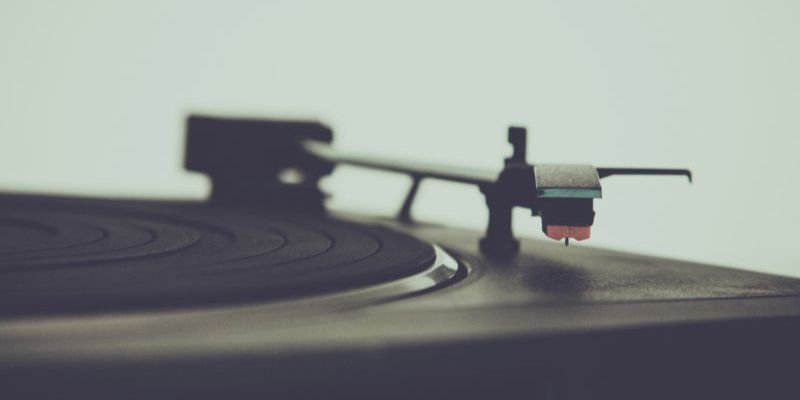Skip to the good bit
ToggleWhat’s more, platter mats also contribute to how your turntable looks and are available in multiple materials and styles, which you will need to consider before making a purchase.
To help you choose the right platter mat for your turntable, we explain what they are, how they work, and which materials you have to choose from.
What is a platter mat, and why is it important?
A turntable platter mat is a thin, disc-shaped object that sits underneath a record before spinning. The mat is similar to the platter itself and typically has a thickness between 1.5 and 4.0mm. The primary role of a platter mat is to enhance the sound quality of your record.
It does this by minimizing vibrations between the parts of your turntable, and when used correctly, you will have a much more enjoyable listening experience. A platter mat also limits your records skip, which creates a much more natural sound.
Newbie record player owners don’t often consider investing in a quality platter mat, but doing so can have a hugely positive impact on the overall sound quality of your device. After all, platter mats are fundamental to how record players work.
But which type of platter mat should you go for? Let’s now look at the most popular types of platter mats available.

Choosing the correct type of platter mat for your system
Platter mats are available in several materials and styles, and the type you opt for is down to personal preference, as they all work in similar ways. That being said, there are some worthwhile distinctions you need to make to ensure you pick a platter mat that is best suited to your record player.
The main thing you need to think about when choosing a platter mat is the material you want to go for. Lots of record players come with a cheap felt mat, which doesn’t do a lot for the overall sound quality of your records.
But you can upgrade your platter mat and choose from cork, rubber, leather, or acrylic, depending on your preference. Aesthetics should play an essential role in your decision, but the material you opt for will also affect sound quality, as we explain in more detail below.
Different types of platter mat
Felt
As mentioned, many systems come with a low-grade felt platter mat as standard. They come in various styles, designs, and colors and can even be personalized to give your record player a much more unique vibe.
Felt platter mats are ideal for home use and reasonably serve their fundamental purpose. One thing to be mindful of with felt mats is that they’re known for attracting static, dust and hair that can negatively impact your system.
They’re also lightweight and feel cheap compared to some of the other mats we introduce below. Still, a felt platter mat is better than no platter mat, so it’s worth considering if you’re looking for something cheap and cheerful.
Cork
If you’re keen to maximize the sound quality of your record player, investing in a cork platter mat is a smart move. Although reasonably inexpensive, cork platter mats are renowned for smoothening the contact between the record and the platter, making it super easy to detach.
This contrasts with felt mats that often stick to the record once the tracks are over, which reduces the likelihood of you damaging your record. Many record player owners agree that cork platter mats enhance the sound quality of their records, which is another plus point to consider.
One of the main drawbacks of cork as a material is that your platter mat may start flaking after an extended period, so you will need to be particularly careful if you notice this happening. After all, you don’t want pieces of cork becoming stuck in your records.
Rubber
Rubber platter mats have the bonus of being a little heavier than those already introduced, which provides your player with additional stability. This ensures the record sits utterly flat on the mat, which reduces the likelihood of vibrations disturbing the sound quality.
Although they might not look as attractive as cork mats, rubber platter mats are equally as effective. You also don’t have to worry about the record skipping, which is a common complaint of many who are new to using turntables.
One issue that you might find with rubber mats is that they give off a funny burnt smell after a time, which is usually caused by friction. While this doesn’t affect sound quality, it might not be an ideal characteristic for everyone!
Leather
While not as popular as the options introduced above, leather platter mats look the part and are an excellent option from an aesthetic standpoint. They’re durable, long-lasting, and bring an element of class to your record player.
In terms of sound quality, leather platter mats produce a deep, warm sound and are perfect for bass notes, but not everyone agrees on this point! Some believe that the additional weight of leather dampens the sound quality, but it’s ultimately down to personal preference.
Another potential drawback of leather platter mats is their price, as they’re typically three or four times more expensive than other materials. That being said, you can’t put a price on quality and are worth the investment if you’re looking for something to upgrade your home turntable!

The verdict: which is the best type of platter mat for your turntable?
It’s hard to say definitively which is the best type of platter mat for a turntable. That being said, we would say that cork and rubber are perhaps your best bet, as they dampen vibrations and improve the overall sound quality of your records.
Felt platter mats are a bit lightweight, and they aren’t as effective at dampening vibrations and preventing your tracks from skipping. On the other hand, Leather is perhaps a little too heavy for some and is often accused of dampening the sound.
Whichever type of platter mat you opt for, you must buy one! Platter mats are a vital component of turntables and will ensure you can sit back, relax, and listen to your records without worrying about the sound quality.








